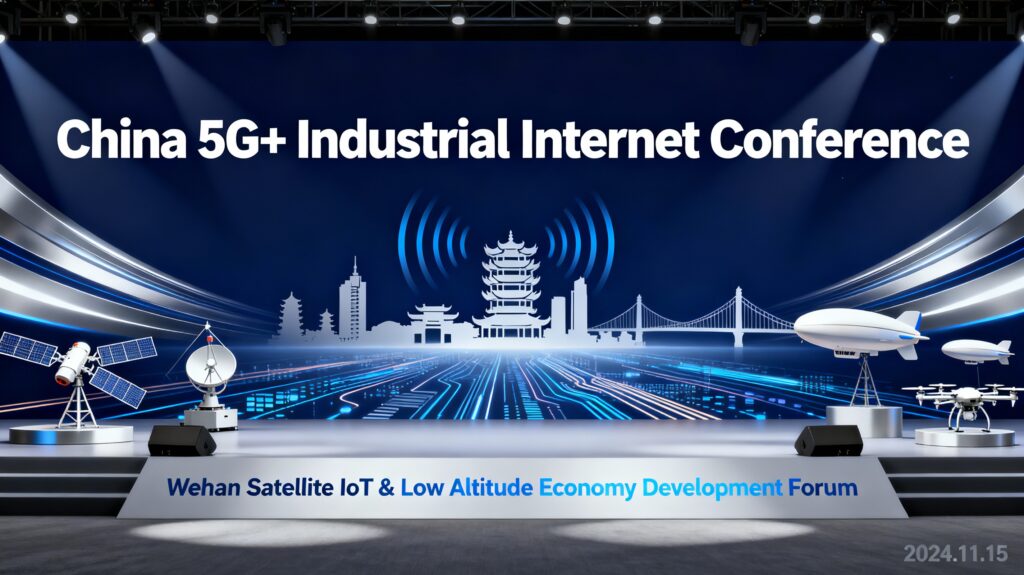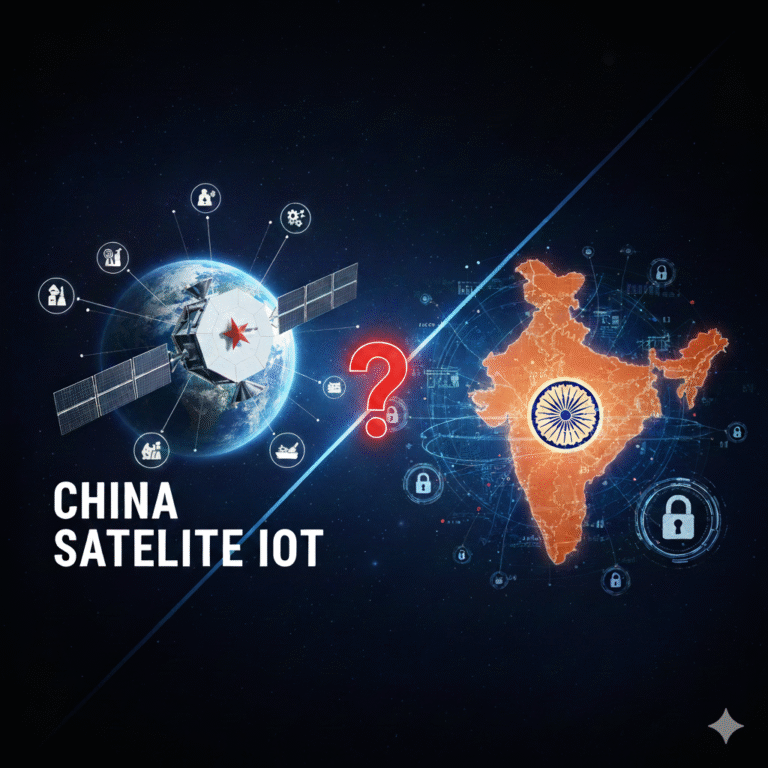Key Highlights
- China has launched a two-year commercial trial of satellite IoT services to diversify satellite communication supply and support commercial aerospace and low-altitude economy.
- The trial is anchored in the 2025 China 5G+ Industrial Internet Conference and MIIT’s August 2025 guidance on optimized market access for satellite communications.
- Satellite IoT will power marine fisheries, logistics, energy, emergency response, and drone-based low-altitude services, especially where 4G/5G networks cannot reliably reach.
- Strategically, China is using satellite IoT to reduce dependence on foreign systems, shape future standards, and strengthen command-and-control over remote assets.
- For India, the move is a wake-up call to develop coherent satellite IoT policy aligned with Digital India, PM Gati Shakti, Blue Economy, Drone Rules, and space reforms.
Understanding Satellite IoT: Beyond Towers and Fiber
Satellite Internet of Things (IoT) refers to connecting huge numbers of devices—on land, sea, and in the air—using satellites instead of only terrestrial towers or fiber. These devices can be fishing boats, oil pipeline sensors, agricultural drones, cargo containers or flood monitoring gauges.
In simple terms:
- Terrestrial IoT (4G/5G/fiber)
- Great for high-density urban/industrial zones.
- Struggles in mountains, oceans, deserts, and disaster-hit areas.
- Dependent on power, towers, and backhaul networks.
- Satellite IoT
- Uses mainly LEO satellites (200–2,000 km altitude) for low latency and wide coverage.
- Trades high bandwidth for low-rate but highly reliable, wide-area connectivity (e.g., a few kilobytes per second per device, but from almost anywhere).
- Ideal for “connect once in a while, but from anywhere” use-cases: telemetry, tracking, alerts.

satellite IoT fits into non-terrestrial networks (NTN) and future 6G “space–terrestrial fusion”, where satellites, drones, and ground networks form one integrated infrastructure.
China’s Commercial Satellite IoT Trial: What Exactly Is Happening?
China has officially launched a two-year commercial trial of satellite IoT services, announced at the 2025 China 5G+ Industrial Internet Conference in Wuhan.
Duration and Scope
- Trial Duration: 2 years (announced November 2025).
- Platform: 2025 China 5G+ Industrial Internet Conference, which serves as a coordination hub for 5G, industrial internet, and now satellite IoT agendas.
- Implementing Authority: Ministry of Industry and Information Technology (MIIT), China’s key digital and industrial regulator.

Stated Objectives
According to Xinhua/China Daily coverage and MIIT-linked statements:
- Diversify satellite communication supply
Move beyond legacy state-run systems to a mix of state-owned and private players in satellite IoT. - Stimulate market vitality
Encourage more firms to build applications, terminals and services, driving demand for satellite launches and industrial chain development. - Enhance service capabilities
Improve coverage, reliability, and capacity of satellite communications as “new infrastructure”. - Build security and regulatory systems
Establish security supervision frameworks and replicable models for scaling up commercial satellite IoT nationwide.
In August 2025, MIIT also issued guidance on optimizing business access for satellite communication, detailing how licenses, standards and enterprise roles will evolve as the market opens up.
Sectoral Application Scenarios: Where Satellite IoT Actually Matters
China’s official framing is very concrete about who will use satellite IoT and why:

1. Marine Fisheries
- Real-time vessel tracking and safety alerts in distant waters.
- Monitoring illegal, unreported and unregulated (IUU) fishing).
- Transmission of catch data, route logs, and weather warnings.
2. Transportation and Logistics
- End-to-end tracking of containers, trains and trucks through remote stretches with patchy cellular signals.
- Cold-chain monitoring for pharmaceuticals and food supply.
- Cross-border freight where roaming and coverage are problematic.
3. Energy and Water Resources
- Condition monitoring of oil & gas pipelines, remote substations, dams, and reservoirs.
- Leak detection, structural health monitoring, and predictive maintenance data from locations with no fiber or 4G/5G towers.
4. Emergency Communications and Disaster Response
- When earthquakes, floods or cyclones damage terrestrial networks, satellite IoT terminals on drones and vehicles keep sending back situational data.
- Coordination between command centers and field teams even when ground towers are out.
5. Low-Altitude Economy (Drones, UAV Logistics, Air Taxis)
China explicitly links satellite IoT with its “low-altitude economy” push—drones, logistics UAVs, future air taxis:
- Drones conducting agricultural spraying, mapping, or inspection rely on satellite IoT for cross-regional scheduling and flight data transmission.
- Emergency rescue drones maintain links to command centers even where mobile coverage is absent.
- In future, UAM/air taxis will need resilient, multi-layer connectivity—satellite IoT provides a fallback when cellular networks fail.
6. Industrial Internet and Smart Manufacturing
- Industrial IoT sensors deployed across large industrial corridors, mines, or construction sites send high-value, low-volume data via satellite.
- Supports real-time decision-making by feeding data into AI/analytics platforms and digital twins.
In all these sectors, the key value of satellite IoT is resilience and coverage, not raw bandwidth: it keeps critical data flowing from remote or high-risk zones when regular connectivity collapses.
Policy and Regulatory Architecture in China
China is not treating satellite IoT as a standalone experiment; it is embedding it within a broader industrial and digital policy stack.
2025 China 5G+ Industrial Internet Conference
The Wuhan conference acts as policy theatre plus coordination platform: 5G, industrial internet, satellite IoT, and low-altitude economy are showcased as one integrated vision.
- Exhibitions include satellite IoT models, terminals connected to Tiantong satellites, and live demonstrations of satellite-linked devices.
- It signals to provinces, SOEs and private firms: “this is a national priority”.
August 2025 MIIT Guidance
MIIT’s Guiding Opinions on Optimizing Business Access to Promote the Development of the Satellite Communications Industry do three important things:
- Optimize Market Access
Streamline licensing, categorize enterprise roles (state-owned satellite firms, telecom operators, private application developers). - Open Up Satellite Services
Encourage experiments and commercial trials of satellite IoT, not just restricted, specialized military/state use. - Emphasize “Safe and Healthy Development”
Stress national security, cybersecurity, and data control even as the market is opened.
From a governance lens (GS2), this is a classic state-steering + market participation model: the state sets strategic direction, but uses private innovation and capital to execute.
Satellite Communication as “New Infrastructure”
Chinese policy documents since 2020 have labeled satellite communications as part of “new infrastructure”, alongside 5G, AI, industrial internet and data centers.
By 2025, officials describe satellite communication as being on a “fast track”, with progress in:
- Constellation construction – multiple LEO constellations (e.g., GW constellation, Geely Constellation, China Unicom networks) already being deployed.
- Technological breakthroughs – direct-to-phone satellite communications, 3GPP-based narrowband IoT over satellites, space–ground fusion for 6G.
- Industrial chain development – manufacturing capacity of 100–150 small satellites (under 500 kg) per year reported by some firms, fueling launch and downstream service ecosystems.
Essentially, satellite IoT is not an isolated telecom experiment; it is being framed as foundational to China’s digital economy, industrial upgrading, and future 6G leadership.
Strategic, Economic, and Security Implications (Global View)
Strategic
- Standards and Global Rules
Through China Standards 2035 and related initiatives, Beijing wants to shape global norms for IoT, 5G/6G, and possibly satellite IoT protocols and interfaces. - Reduced Dependence on Foreign Systems
By building domestic satellite IoT constellations and standards, China reduces reliance on foreign GNSS/IoT platforms and potential external choke points.
Economic
- Digitalization of Traditional Sectors
Fisheries, logistics, energy, agriculture and water management become data-rich and AI-enabled, improving productivity and reducing losses. - Low-Altitude Economy
Drones, logistics UAVs, and future air taxis gain reliable, wide-area communications—a precondition for scaling business models safely. - Industrial Chain Growth
Satellite IoT trials spur demand for satellites, launch services, terminals, chips, platforms, turning space into a demand-driven industrial flywheel.
Security
- Command, Control, Situational Awareness
Satellite IoT gives the state and large enterprises persistent visibility over vehicles, vessels, drones, and remote assets, enhancing both economic efficiency and strategic control. - Cybersecurity and Dual-Use Risks
The same networks can support military logistics, surveillance and targeting, raising classic dual-use governance questions.
Linkages and Lessons for India
China’s satellite IoT trial is a live case-study for India on how to link space, digital infrastructure, and industrial policy.
Relevance for Indian Initiatives
- Digital India & BharatNet
Satellite IoT can complement BharatNet by connecting last-mile sensors and devices where even fiber + Wi-Fi penetration is low (Himalayan, NE, island and LWE-affected areas). - PM Gati Shakti & Logistics Corridors
Real-time satellite IoT tracking of freight trains, highway logistics, multimodal cargo, and port traffic aligns directly with PM Gati Shakti’s multi-modal integration focus. - Blue Economy & Fisheries
India’s distant-water fishing fleets, coastal surveillance, and deep-sea exploration could benefit from satellite IoT connectivity similar to China’s marine fisheries use-case. - Drone Rules, Low-Altitude Economy, and UTM
As India liberalizes drone rules and develops UTM (Unmanned Aircraft Traffic Management), resilient connectivity via satellite IoT can support BVLOS (Beyond Visual Line of Sight) operations. - Industrial Corridors and Smart Manufacturing
Satellite IoT aids predictive maintenance, asset monitoring, and environmental compliance across long industrial belts where tower deployment is sparse.
Potential Indian Focus Areas
- Fisheries & coastal security
- Himalayan/NE connectivity & border management
- Disaster management and NDMA/SDMA operations
- Irrigation channels, river-linking projects, groundwater monitoring
- Dedicated corridors under Sagarmala, Bharatmala, and freight corridors
Policy Questions for India
- Spectrum and Licensing for Satellite IoT
- Should satellite IoT be licensed under existing VSAT/satcom regimes or need a dedicated category?
- How to coordinate with 5G/6G NTN bands to avoid harmful interference?
- Integration with 5G/6G & Industrial IoT Plans
- How should DoT, TRAI, and IN-SPACe align policies so that space-based IoT becomes part of India’s 6G roadmap, not an afterthought?
- Data Sovereignty and Cybersecurity
- If foreign satellite IoT providers operate in India, how will data localization, lawful interception, and encryption be enforced?
- What standards should apply to dual-use and high-risk sectors (ports, power, defense-adjacent assets)?
Governance, Ethics, and International Cooperation
As constellations and satellite IoT ecosystems proliferate, several governance and ethical issues arise:
- Space Traffic Management & Orbital Congestion
More satellites for IoT = more congestion and debris risks. International norms on collision avoidance, post-mission disposal, and mega-constellation behaviour become essential. - Standards and Protocols
China, the EU, the U.S. and others will push their preferred IoT/NTN standards. India must decide whether to follow, adapt or co-create such standards via ITU, 3GPP, and multilateral fora. - Privacy and Surveillance
Satellite IoT networks, especially when tied to state-owned or Big Tech actors, can enable fine-grained tracking of people, vehicles and activities. Safeguards, anonymisation and oversight mechanisms will be crucial. - Dual-Use Risks
The same networks that enable smart supply chains and fisheries can underpin military logistics and targeting, blurring lines between civilian and military infrastructure.
For India, active diplomacy in COPUOS, ITU and 3GPP, plus regional coalitions, will be necessary to ensure that space-based IoT remains open, interoperable, and responsible, rather than another arena of technological dependency.
Policy Options and Recommendations for India
Short to Medium Term:
- Frame a dedicated satellite IoT policy under DoT/IN-SPACe, clarifying licensing, spectrum bands, foreign participation limits, and data localization for IoT traffic.
- Run pilot projects in coastal fisheries, disaster-prone districts, and Himalayan/NE regions using satellite IoT, ideally with Indian firms and ISRO/NSIL involvement.
- Integrate satellite IoT thinking into National Logistics Policy, PM Gati Shakti, Drone Rules and upcoming 6G strategy.
Medium to Long Term:
- Encourage Indian players (ISRO, NSIL, private constellations) to build indigenous LEO IoT constellations or payloads, reducing future dependence on foreign platforms.
- Invest in terminal, chip, and antenna ecosystems for satellite IoT—an area where Indian startups and MSMEs can specialise.
- Proactively shape global norms on satellite IoT standards, space traffic management, and cross-border IoT data flows through multilateral engagement.








+ There are no comments
Add yours